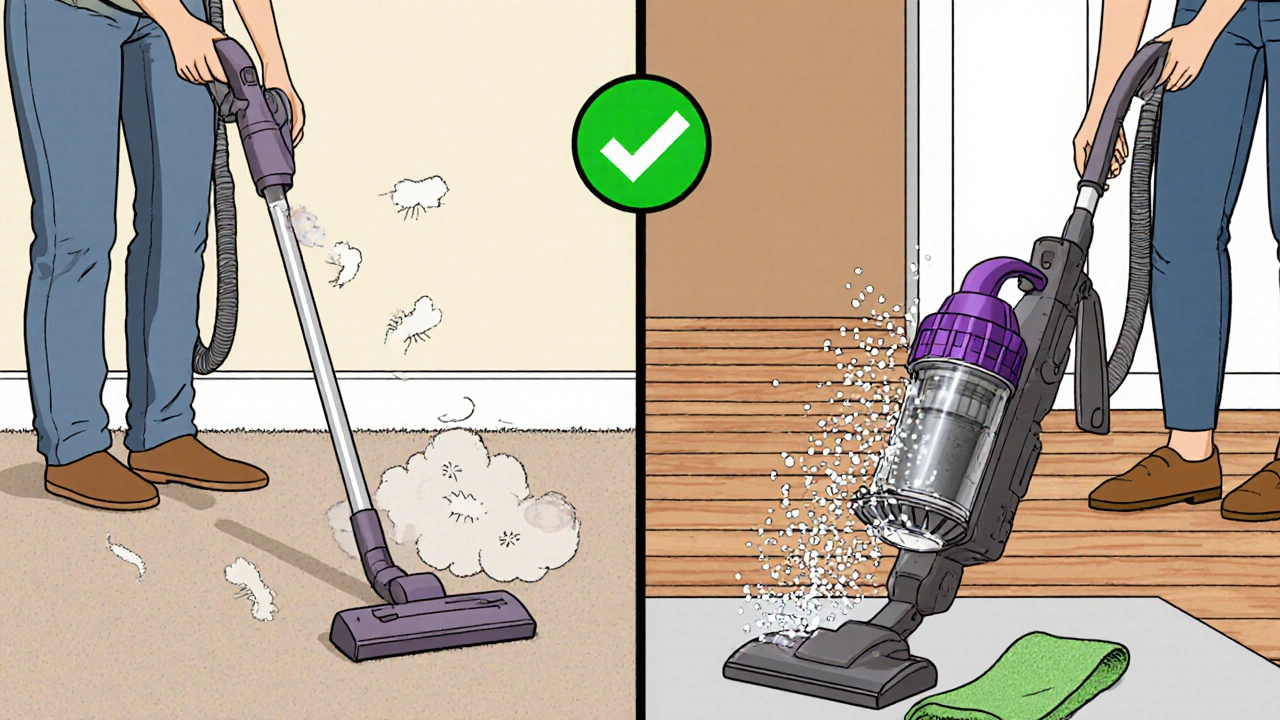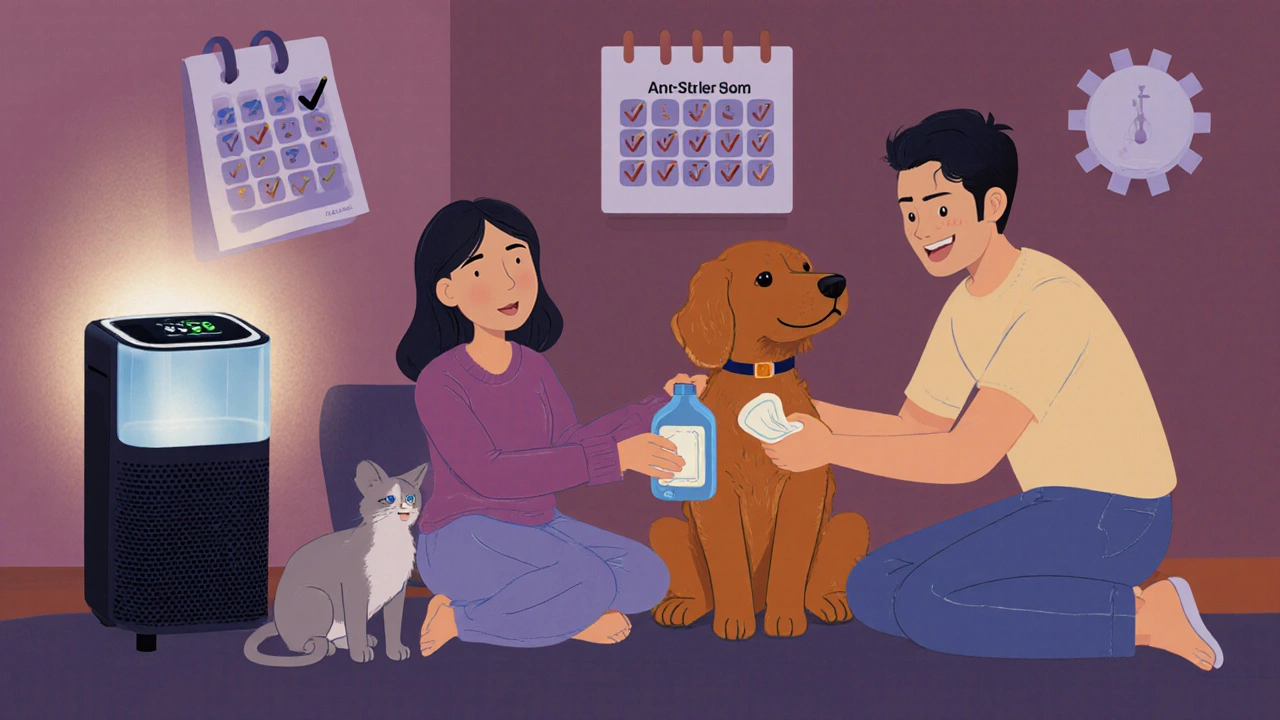Why Pet Dander Triggers Allergies (It’s Not the Hair)
You love your cat or dog, but your nose won’t stop running, your eyes itch, and you’re constantly sneezing. You blame the fur, but the real culprit isn’t hair at all. Pet allergies are caused by tiny proteins in dander-microscopic flakes of skin-plus saliva and urine. These proteins stick to fur, furniture, and even your clothes. When you breathe them in, your immune system overreacts, treating them like invaders. That’s when symptoms like congestion, watery eyes, and coughing kick in.
Not all pets are equal when it comes to allergens. Cats produce a protein called Fel d 1, mainly in their skin glands and saliva. Dogs produce Can f 1, found in their skin and saliva. Both are incredibly sticky and light, floating in the air for hours and clinging to walls, carpets, and bedding. Even after a pet leaves a home, these allergens can linger for months. And no, there’s no such thing as a truly hypoallergenic breed. A short-haired cat or a poodle may shed less hair, but they still produce the same allergens. Individual animals vary more than breed does.
Stop Allergens at the Door: The Bedroom Rule
The single most effective thing you can do? Keep pets out of the bedroom. This isn’t just a suggestion-it’s backed by clinical studies. When pet allergens are kept out of the bedroom, nighttime symptoms drop by up to 40%. Why? Because you spend a third of your life there, breathing in dust and dander while you sleep. If your pet sleeps on the bed, they’re spreading allergens directly onto your pillow and sheets. Even if they don’t sleep in the room, they can still track allergens in on their paws or fur.
Make the bedroom a pet-free zone. Use a baby gate or close the door. If your pet is used to sleeping with you, start by letting them sleep just outside the door for a few nights. Gradually move them to another room. You might be surprised how quickly they adapt. And don’t forget to wash your bedding weekly at 130°F (54°C). That temperature kills allergens and removes trapped dander from fabric fibers.
Upgrade Your Cleaning Tools: HEPA Is Non-Negotiable
Standard vacuums don’t cut it. They blow allergens back into the air through their filters. What you need is a vacuum with a true HEPA filter. HEPA stands for High-Efficiency Particulate Air. These filters capture 99.97% of particles as small as 0.3 microns-including pet dander. Studies show HEPA vacuums remove 30-50% more allergens than regular models.
Don’t just vacuum the floor. Clean upholstery, curtains, and even your pet’s favorite chair. Vacuum at least two to three times a week. If you have carpets, consider replacing them with hardwood, tile, or linoleum. Carpets trap dander deep in the fibers, and even deep cleaning doesn’t get it all out. Hard floors are 50-75% less likely to hold onto allergens.
Pair your vacuum with an air purifier. Look for one with a true HEPA filter and a CADR (Clean Air Delivery Rate) rating that matches your room size. A good air purifier can reduce airborne allergens by 40-60% in a standard bedroom or living room. Place it where you spend the most time-usually the bedroom or living room. Run it on high for an hour after vacuuming to catch the stirred-up particles.

Wash, Wipe, and Rinse: Daily Habits That Make a Difference
It’s not just about cleaning the house-it’s about stopping allergens before they spread. Wash your hands immediately after petting your animal. That simple habit cuts allergen transfer to your face by 90%. Use a lint roller on your clothes and furniture every day. It removes 70-85% of surface dander in seconds.
Wash your pet’s bedding weekly at high heat. Use a pet-safe detergent. If your pet has a favorite blanket or toy, toss it in the dryer on high for 10 minutes after washing to kill any remaining allergens. Bathe your pet at least once a week. This reduces allergen levels on their skin and fur. It’s not always easy-cats especially hate water-but there are dry shampoos and wipes designed for allergen reduction. Look for products labeled “anti-allergen” or “dander-reducing.” Independent tests show these can reduce allergen potency by 30-70% for up to 72 hours.
Wipe down surfaces daily with a damp cloth. Dust attracts dander, so don’t let it build up. Use a microfiber cloth-it traps particles instead of spreading them. Avoid feather dusters. They just kick allergens into the air.
Medications and Long-Term Solutions
Environmental changes help, but they don’t always eliminate symptoms. If you’re still struggling, medications can fill the gap. Over-the-counter antihistamines like loratadine or cetirizine work for 60-70% of people with mild symptoms. They start working in 30-60 minutes and last all day. Nasal sprays with corticosteroids (like fluticasone) reduce inflammation and congestion with daily use.
For long-term relief, consider immunotherapy. Allergy shots or sublingual tablets (like Odactra for cat allergies) train your immune system to stop reacting. After 3-5 years of treatment, 80-85% of patients see lasting improvement-even after stopping. Odactra, approved by the FDA in 2023, is a daily tablet placed under the tongue. It’s as effective as shots but easier to take.
Immunotherapy isn’t a quick fix. It takes time and commitment. But for people who want to keep their pets long-term, it’s the closest thing to a cure. Talk to an allergist if your symptoms are persistent or affecting your sleep or daily life.

What Doesn’t Work (And Why)
There’s a lot of misinformation out there. Don’t waste money on products that promise “hypoallergenic” breeds. No cat or dog is truly allergen-free. Even hairless breeds like the Sphynx produce Fel d 1. Some people think air fresheners or scented candles help. They don’t. They just mask odors and can irritate your airways more.
Anti-allergen sprays can help, but results vary. Some reduce allergens by 70%, others by just 30%. Look for products tested by independent labs. Avoid ones with strong perfumes. They can trigger asthma or make allergies worse.
And don’t expect overnight results. It takes 4-6 weeks of consistent effort to see real improvement. If you only vacuum once a week or skip pet baths, you won’t get far. Success comes from combining multiple strategies-cleaning, filtering, and medical help.
Cost and Commitment: Is It Worth It?
Setting up a low-allergen home costs $200-$500 upfront: a HEPA vacuum ($150-$300), an air purifier ($100-$250), and a few bottles of pet shampoo ($10-$20). You’ll also need to replace HEPA filters every 6-12 months ($20-$50). That’s a lot, but think of it this way: if you’re spending $100 a month on allergy meds and doctor visits, you’re already paying more.
Households that stick with the plan see a 50-70% drop in measurable allergens within three months. A 2023 Kaiser Permanente survey found that 75% of people who followed these steps reported better symptoms. The real cost isn’t money-it’s time. But if you value your pet and your health, the trade-off is worth it.
What’s Coming Next
The future of pet allergies is getting smarter. Researchers at UC Davis are using CRISPR gene editing to create cats that produce 90% less Fel d 1. That’s not available yet, but it’s coming. In the meantime, smart home systems are starting to appear-devices that monitor allergen levels in real time and automatically turn on air purifiers when levels rise. By 2025, these could be common in homes with allergy sufferers.
Meanwhile, the market for pet allergy products is growing fast. More people are keeping pets, and more people are developing allergies. The solution isn’t giving up your pet. It’s using science, smart habits, and the right tools to live comfortably with them.
Can I still have a pet if I’m allergic?
Yes, you can. Many people with pet allergies live happily with their animals by combining environmental controls (like HEPA filters and pet-free zones) with medical treatments. It’s not about eliminating all allergens-it’s about reducing them enough so symptoms are manageable. Studies show 92% of people using both home strategies and immunotherapy can keep their pets with minimal symptoms.
How long does it take to see results from dander reduction?
Most people notice improvement in 4-6 weeks with consistent effort. Symptoms like sneezing and itchy eyes often get better first. Full allergen reduction in the home can take up to 3 months, especially if you’re replacing carpets or deep-cleaning furniture. Patience and consistency are key.
Do air purifiers really help with pet allergies?
Yes-if they have a true HEPA filter and are sized correctly for the room. Air purifiers reduce airborne allergens by 40-60%. They work best when used with vacuuming and keeping pets out of bedrooms. A purifier alone won’t fix everything, but it’s one of the most effective tools you can add.
Is bathing my pet weekly really necessary?
It’s one of the most effective steps you can take. Weekly baths reduce allergens on the skin and fur by up to 80%. It’s harder with cats-they usually resist water-but there are dry shampoos and wipes designed for allergen control. Even biweekly baths help. Skipping baths means allergens keep building up on your pet and spreading around your home.
Should I get rid of my pet if I’m allergic?
No, not unless all other options have failed. Most people don’t need to rehome their pets. With a combination of HEPA filters, pet-free zones, regular cleaning, and possibly allergy shots or tablets, you can reduce allergens enough to live comfortably. Giving up a pet is emotional and often unnecessary. Try the full strategy first-many families succeed without giving up their animals.


Samkelo Bodwana
November 19, 2025 AT 04:28Man, I never realized how much dander sticks to everything until I got a new cat and started sneezing every time I sat on my couch. I thought it was the fur, but turns out it’s the skin flakes and saliva-wild. I started keeping my cat out of the bedroom and holy hell, my nights improved instantly. I used to wake up with a clogged nose and itchy eyes, now I actually sleep. Also, washing bedding at 130°F? I didn’t know that was a thing. Now I do it every Sunday like clockwork. It’s not glamorous, but it works.
I also got one of those cheap HEPA vacuums off Amazon and it’s a game changer. My old vacuum just blew dust everywhere like a tornado. This one actually sucks it in and keeps it there. I vacuum the couch, the stairs, even the curtains now. My dog doesn’t care, he just lies there like he owns the place-which he does.
And yeah, no such thing as hypoallergenic breeds. I had a friend swear her poodle was allergy-free, but her kid still broke out in hives. Turns out, it’s the protein, not the hair. Even hairless cats? Still spew Fel d 1 like it’s their job. I think people just want to believe there’s a magic solution. There isn’t. Just hard work and consistency.
Wiping surfaces with a damp microfiber cloth daily? I thought that was overkill. Now I do it while watching TV. Takes five minutes. Feels like I’m doing something productive. And I swear, after a month, the dust on my shelves just… disappeared. It’s not magic, it’s physics. Dander sticks to dust. Remove dust, remove allergens.
Washing my cat’s bed weekly? I used to forget. Now I toss it in the dryer for 10 minutes after washing. The heat kills the little bastards. I even bought those anti-allergen wipes for her fur. She hates it, but I don’t care. I’d rather have a grumpy cat than a congested nose.
I didn’t believe in air purifiers until I bought one. Now I have it running in the living room and bedroom. I can’t prove it scientifically, but I can feel the difference. My eyes don’t water as much. My throat doesn’t feel scratchy. I’m not saying it’s perfect, but it’s a big help when combined with everything else.
And immunotherapy? I’m considering it. I’ve been on antihistamines for two years. They help, but I feel foggy. I don’t want to be on pills forever. If I can train my body to stop freaking out over my own cat, that’s the dream. I’ll talk to my allergist next month. Worth a shot.
Bottom line: you don’t have to give up your pet. You just have to be a little obsessive. And honestly? It’s worth it. My cat sleeps on my feet at night. I wouldn’t trade that for all the antihistamines in the world.
deepak kumar
November 19, 2025 AT 08:33Bro, this is gold. I’m from India and we have this thing where people think pets are dirty and allergic people should just give them up. But I’ve got a labrador and my wife has asthma. We did all this stuff-HEPA vacuum, no pets in bedroom, weekly baths, air purifier-and now she doesn’t need her inhaler at night. I mean, we spent like $400 total, and it’s been 8 months. No more sneezing fits at 3 a.m.
Also, the dry shampoo thing? We use a brand called Allerpet. It’s like a wipe you rub on the dog. She hates it, but she tolerates it. We do it every 3 days. Works better than I thought. And no, we didn’t get a ‘hypoallergenic’ breed. Just a big, slobbery golden. Proves it’s not about the breed.
And yeah, the 130°F wash? I didn’t know that either. Now I boil my pillowcases. My wife thinks I’m crazy. But she’s sleeping better. So I win.
Sameer Tawde
November 20, 2025 AT 18:11Just started following this. Made my dog sleep outside the bedroom. First night was rough. Second night, I slept like a log. No more 3 a.m. sneezing. HEPA vacuum? Bought one last week. Already noticed less dust on my desk. Small wins, people. Keep going.
Jeff Hakojarvi
November 22, 2025 AT 06:17Wait, so you’re saying even hairless cats still cause allergies? I had a Sphynx and thought I was in the clear. Nope. My eyes still watered. I thought it was the humidity. Turns out, it was her skin oils. Ugh. I didn’t know about the dry shampoos though. I’ll check those out. Also, the 130°F wash-my washer doesn’t go that hot. Should I use hot water + dryer? Or is that not enough?
Dave Pritchard
November 23, 2025 AT 12:44Jeff, you’re right-dryer heat helps. The CDC says 130°F kills allergens, but if your washer doesn’t hit that, running the dryer on high for 30 minutes after washing is almost as good. I do it with all bedding and pet blankets. Also, don’t forget to clean the lint trap. Dander gets stuck there too.
kim pu
November 24, 2025 AT 09:24Okay but have you heard about the *real* truth? The government and pet companies are hiding the fact that dander is a bioengineered allergen to sell more HEPA filters and antihistamines. They’ve been pumping Fel d 1 into the environment since the 90s. That’s why allergies spiked. The ‘hypoallergenic’ lie? Pure marketing. Even the ‘anti-allergen’ wipes? They’re just masking the truth. I tested mine with a UV light-glowing everywhere. They’re just glitter. And don’t get me started on the air purifiers-they’re just noise machines with a fancy filter. The real solution? Move to Antarctica. No pets. No allergens. No lies.
Angela J
November 26, 2025 AT 08:40OMG I knew it!! I’ve been saying this for YEARS. The pet industry is in cahoots with Big Pharma. They want us to buy all this junk so we stay dependent. I tried the HEPA vacuum and it made my allergies WORSE because it was ‘releasing negative ions’ that triggered my mast cells. I switched to a broom and now I’m fine. Also, I think the cat is a government spy. She stares at me too long. And why do they say ‘hypoallergenic’? That’s a lie. Nothing is hypo-allergic. It’s all a scam. I’m going to write to the FDA.
Timothy Uchechukwu
November 28, 2025 AT 02:24People in the West are so weak. In Nigeria, we grow up with goats, chickens, dogs-all in the house. No one has allergies. You just toughen up. Why are you so soft? Buy medicine? Wash sheets? Use air purifiers? My grandpa had 12 cats and never sneezed. He just spat on the floor and kept going. You need discipline. Not filters. Not wipes. Just willpower. This post is nonsense. You’re letting pets control your life. Grow up.